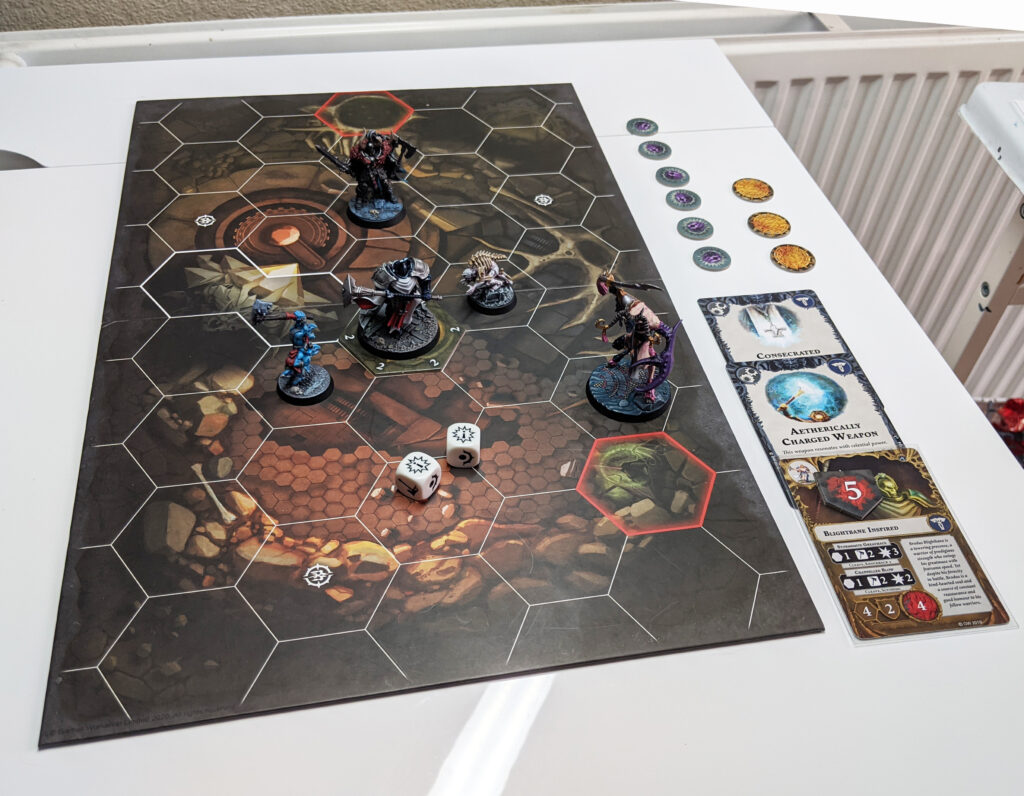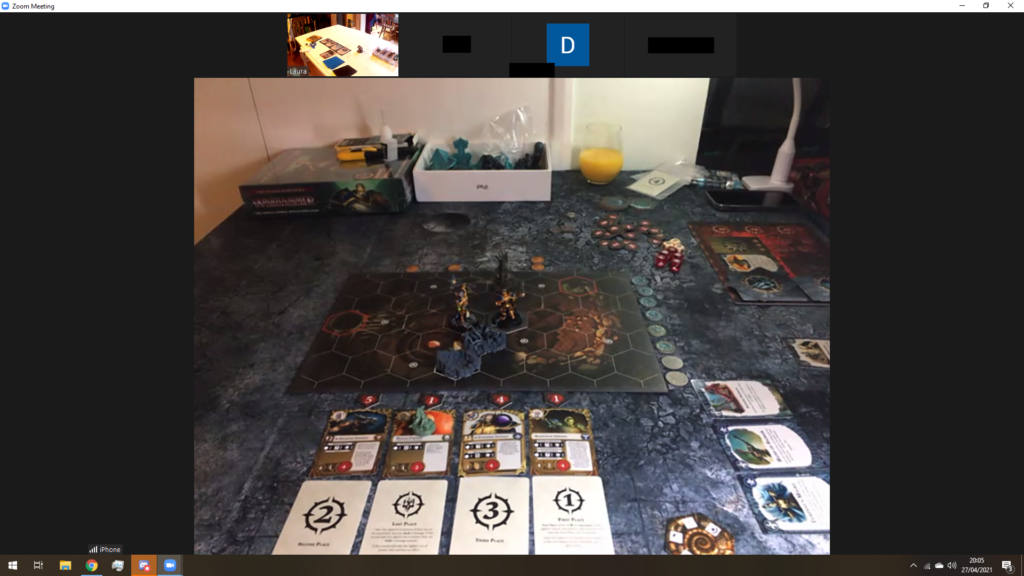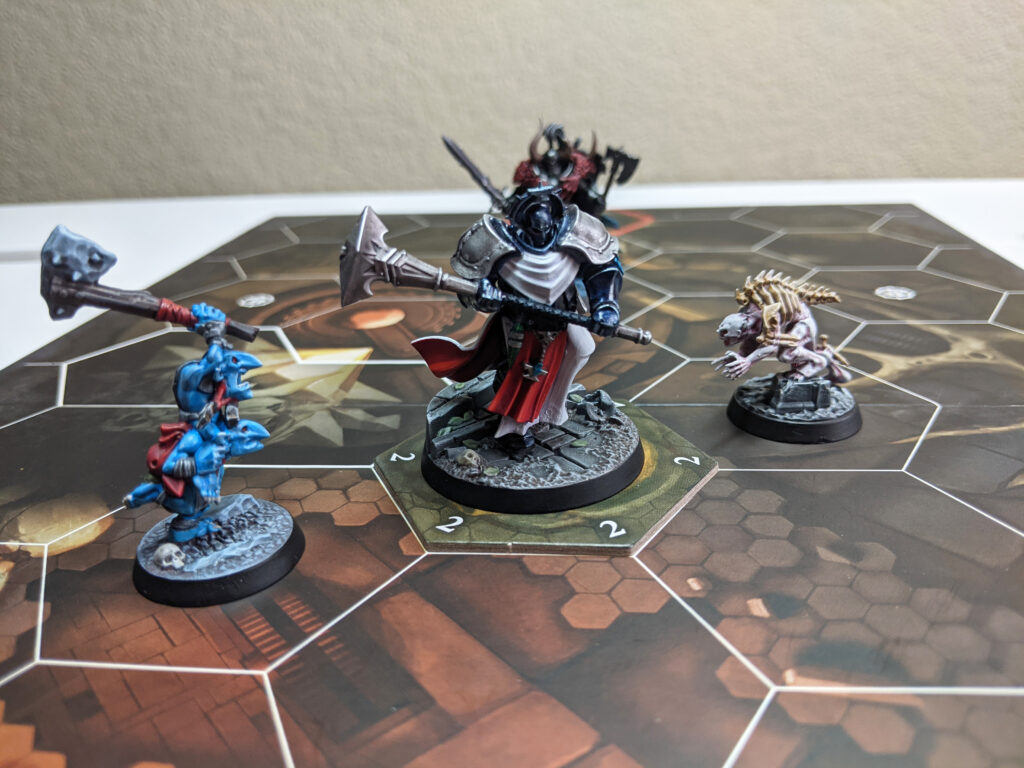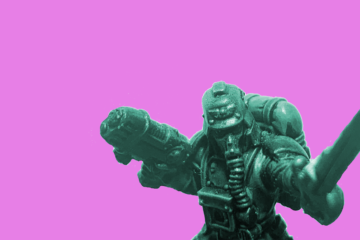Like many Warhammer Underworlds players, when I bought my copy of the multiplayer Arena Mortis Underworlds expansion in late 2020, it was because I wanted the new cards and board to use in organised play. I dumped the Arena Mortis variant rules and tokens in a box in the loft, fully expecting I’d never use them. However, a few months ago one of my regular gaming group suggested that we give Arena Mortis a try, and it ended up being so much fun that we’ve returned to it several times since.
Arena Mortis is a multiplayer expansion for Underworlds for up to six players. The key differences to regular Underworlds are that each player has only one fighter, it doesn’t matter (much) if your fighter dies, and there are no objective cards.
Pick a fighter of your choice from all the fighters in the game (there are over a hundred to choose from), build a deck of upgrade cards for them, and then over up to eight rounds you have a big fight where you try to score glory by taking out your opponents’ fighters, while hopefully not losing your own too often.
If your fighter dies, they are raised from the dead at the start of their next turn, so no one gets eliminated from the game. You get to add new upgrades to your fighter every round, so by the end of the game all the fighters are buffed up killing machines, much more so than you typically see in a regular game of Underworlds.
So, what made Arena Mortis click for me, and why might you want to play it over regular one-on-one Underworlds? Three things:
- It introduces different sorts of strategic choices.
- You get to see Underworlds fighters operating at full power.
- It makes for a fun evening of casual gaming with friends.
A different strategic experience
There are strategic decisions involved in Arena Mortis, but they’re different to those you’d make in a standard game of Underworlds. Most of the important decisions in Arena Mortis come pre-game when you select your fighter and build your deck. The actual game itself is a lot simpler than regular Underworlds, and it’s usually pretty straightforward to decide what to do with your turn.
Fighter selection is the first important choice you’ll need to make. You can choose any fighter from any warband, and the bigger ones aren’t necessarily the best. Arena Mortis has a few balancing mechanics: firstly, weaker fighters start the game with more upgrades, which means more opportunities to create powerful combos. Secondly, fighters with six or more wounds are worth more glory when you kill them in Underworlds, and this rule has more impact in Arena Mortis than in the main game because a fighter is likely to die multiple times. Finally, by the end of the game you’ll typically be in a position when all the fighters are so powerful that regardless of their starting stats they’re likely to all have the potential to one-shot one another.
This isn’t to say some fighters aren’t better than others: in general, good things to consider when picking a fighter are how much damage they do, what special rules they have, and what fighter and warband specific upgrades they have access to. There’s also a psychological factor to consider – if you pick Mollog (the big troll who is the most powerful fighter in the game), all your opponents are likely to pick on you. But if you pick a weak fighter and manage to pull off a win, you’ll get bragging rights over your gaming group.
In the last game I played, one of my opponents chose Knight’s Herald, a Crypt Ghoul from the Grymwatch warband who is pretty weak in the main game – he only has two wounds, and hits for one damage. But he has a special rule that means that fighters next to him get to roll less dice when they attack, which is great in Arena Mortis, and once upgraded with some combo attacks and a damage boost he can easily deal out four or five damage in an attack, so he turned out to be a very solid pick, and very nearly won the game.
Having chosen a fighter, you then need to build an upgrade and a gambit deck for them. The upgrades are the most important thing here, you want to make your fighter as powerful as possible. However, there is a mind games aspect to this, as if an opponent draws an upgrade that you already have, you have to discard yours. This means that when building your upgrade deck, you need to give some consideration to what cards others might be taking. A strong card like Great Strength (which gives extra damage to attacks) is likely to be in most people’s decks, so if you take it you might only get to use it for a round; while a slightly weaker card that no one else has taken will stick around for the rest of the game once you draw it.
Some cards that are great in the main game are rubbish in Arena Mortis and vice versa, so I’ve enjoyed looking at the cards with a fresh eye, and reconsidering cards I wouldn’t normally give a second glance to. For example, Army of One is an upgrade which gives a fighter a significant stats boost if they are your last surviving fighter. In the main game it’s not something you see a lot of, because it’s only situationally useful. But in Arena Mortis you only ever have one surviving fighter, so its effect always applies, making it very strong.

Everyone ends up super-powered
In a regular game of Underworlds, it’s relatively unusual to get more than five or so upgrades on any one fighter, unless you’re playing certain deck or warband archetypes that are based on powering up one individual fighter. In Arena Mortis, your fighters can’t permanently die, and you get to add new upgrades to them every round, so they’ll typically end up with eight or more upgrades. This gives you a chance to try out combos that would be too risky to try in the main game, and roll more dice than you’d normally ever do.
In the last game I played, I took Brodus Blightbane, a Stormcast Eternal fighter, and built my upgrade deck to make him as hard to kill as possible. He ended up rolling three defence dice with two re-rolls, ignoring the first critical hit rolled, and reducing all damage taken by one; which had the result of making him a very unpopular target compared to the other less well defended fighters on the board. On the other hand, one of my opponents was rolling seven dice for each attack, meaning that they were pretty much guaranteed to roll some successes.
Arena Mortis is a great opportunity to push the limits of how powerful Underworlds fighters can get, and try out combos that wouldn’t be worth it in the main game where you might only get to use them once and there’s too high a risk of your fighter dying before you draw the right cards. It’s fun to roll a lot of dice, and it’s fun to see what horrible combos your friends have managed to come up that you wish you’d thought of first.
Multiplayer fun
Arena Mortis falls into the category of what are often called ‘beer and pretzels’ games: once you’ve got the deck building element out of the way it doesn’t require too much complex thought or planning, and it doesn’t take long to play a turn. The multi-player element is something I’ve really enjoyed, during the pandemic all of my Warhammer Underworlds gaming has been over webcam, which means I’ve typically been playing in a Zoom breakout room with one other person. When we play Arena Mortis we don’t have to split out into separate breakout rooms, so it’s a much more sociable experience.

The game is designed with a catch-up mechanic whereby if you are winning the game, other players get extra glory for taking your fighter out of action. This means that the lead tends to change hands a lot of times during the game, and games will often be very close. I don’t always enjoy catch-up mechanics in games as they can reduce the skill factor involved, but in this case I think it works well. It makes it unlikely that you’ll have a runaway leader early on, and means that if you have some bad dice luck in the first few rounds you still have potential to stage a comeback later.
Overall, there is more luck and less skill involved than in standard one-on-one Underworlds, but sometimes it’s nice just to roll some dice and see what happens without having to think for too long about the optimal move to make on your turn, or try to remember whether your opponent has played Distraction yet.

In conclusion
To wrap things up, if you or someone in your gaming group has got Arena Mortis and you’ve not played a game of it yet, I’d encourage you to give it a go. It takes longer than a normal game of Underworlds (over webcam we’ve found it takes about an hour and a half for a game, it would probably be quicker face to face), but it’s got some interesting differences from the main game, and I’ve really enjoyed giving it a try.



